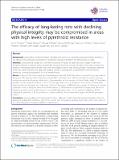| dc.contributor.author | Eric O Ochomo, Nabie M Bayoh, Edward D Walker, Bernard O Abongo, Maurice O Ombok, Collins Ouma, Andrew K Githeko, John Vulule, Guiyun Yan, John E Gimnig | |
| dc.description.abstract | Background
Long-lasting insecticide-treated mosquito nets (LLINs) are a primary malaria prevention strategy in sub-Saharan Africa. However, emergence of insecticide resistance threatens the effectiveness of LLINs.
Methods
Cross-sectional surveys of LLINs were conducted in houses of seven and four villages in Gem and Bungoma Districts in western Kenya, respectively. Condition (number and area of holes in the nets), number and species of mosquitoes resting inside them, and insecticidal activity of nets were quantified. Mosquitoes collected inside nets were allowed to lay eggs and progeny tested for susceptibility to deltamethrin and permethrin, pyrethoids commonly deployed in LLINs in western Kenya.
Results
In Gem, 83.3% of nets were less than three years old and 32.4% had at least one hole of any size; while in Bungoma, 92% were less than three years old and 48% had at least one hole. No anopheline and five Culex spp. mosquitoes were found resting inside nets in Gem regardless of the number and size of holes, while 552 Anopheles gambiae s.l., five Anopheles funestus s.l. and 137 Culex spp. were in nets in Bungoma. The number of mosquitoes resting inside nets increased with hole areas >50 cm in Bungoma. In WHO resistance assays, f1 offspring of samples collected in nets in Bungoma were 94 and 65% resistant to deltamethrin and permethrin, respectively. Nets from Bungoma retained strong activity against a susceptible laboratory strain, but not against f1 offspring of field-collected An. gambiae s.s. All An. gambiae s.s. samples collected in nets were homozygous for the kdr genotype L1014S.
Conclusions
In areas with pyrethroid resistant vectors, LLINs with modest hole areas permit mosquito entry and feeding, providing little protection against the vectors. LLIN formulations develop large holes within three years of use, diminishing their presupposed lifetime effectiveness. | en_US |

